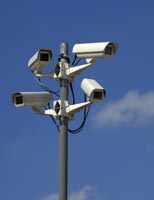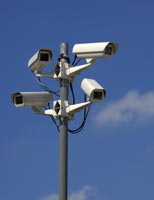
The Power of PoE
Convergence faces the challenges of infrastructure and flexibility
- By Koen Geirnaert
- Apr 01, 2008
 With an explosive demand for security monitoring worldwide, cameras are appearing in every conceivable location. The challenge is how to support this rapidly growing infrastructure with affordable and flexible real-world solutions. The adoption of PoE offers new opportunities for the design of products directly powered over Ethernet lines, drastically reducing overall installation and maintenance costs.
With an explosive demand for security monitoring worldwide, cameras are appearing in every conceivable location. The challenge is how to support this rapidly growing infrastructure with affordable and flexible real-world solutions. The adoption of PoE offers new opportunities for the design of products directly powered over Ethernet lines, drastically reducing overall installation and maintenance costs.
In the video surveillance market, the days of analog CCTV cameras are numbered. The IP camera is encroaching on the analog camera's domain while security awareness is boosting the installed base of cameras. In addition to cameras, the market for access systems, RFID tracking, biometric identification, fire detectors and other security equipment continues to expand. Some of these systems require high-bandwidth networks to operate. Due to the widespread availability of IP networks, Ethernet is poised to become the dominant network for security systems. As more devices are connected over Ethernet, the momentum continues to build toward virtually everything being interconnected.
The Convergence Trend
In the security industry, like many other industries, IP convergence is a key driver. The convergence of all security equipment on the same network has many advantages. Security equipment can be accessed from anywhere via the Web. The security network benefits from technology such as firewalls and secure connectivity software with encryption. Total cost of ownership for the security network infrastructure is lower with off-the-shelf interfaces and switches. Installation flexibility is increased thanks to adding, moving or removing equipment to plug-and-play; therefore the system configuration can be modified quickly, allowing system enhancements and incremental capital investments. Building security networks and enterprise data networks are starting to converge.
Another important trend in the security world is integration. Numerous features and capabilities are being added to security systems. In recent years, security cameras profited from numerous technology advances. Today, CMOS image sensors lead to improved image quality and higher frame rates. Network and media processors enable the handling of captured image data and organize them into IP packets. PoE was introduced on the box camera. Tracking capabilities were implemented via onboard stepper motors. Now, the camera market is ready to add even more features, such as speakers, microphones, sensors, door-lock interfaces and fire detectors. The camera is evolving into a comprehensive integrated security tool.
PoE has taken off in the security camera market. Today, a significant share of box cameras have a PoE-powered device on board. PoE is well positioned to bring additional power to enable the convergence and integration trends in the security market.
An Evolving Standard
Initially, the IEEE802.3af PoE standard supported the modest power needs of devices such as VoIP phones, wireless LAN access points and even box cameras. But the standard is evolving to the higher-powered IEEE802.3at, also called PoE+. This standard supports delivery of even higher power levels, which in turn serves the convergence principle. With PoE+, most types of cameras can be connected at virtually any point on the network. No power plugs need to be provided, additional wiring can be avoided and repositioning is plug-and-play. Power supply backup via an uninterruptible power supply on the Ethernet switch is easy to implement with PoE-enabled systems.
In the market today, PoE convergence has encompassed the box camera as long as power consumption is within the 13-watt power budget of the IEEE802.3af standard. With the development of the IEEE802.3at PoE+ standard and its 30-watt capability, the security market will be able to include PTZ and dome cameras in the power budget.
The desire to integrate more capabilities on the camera platform also is driving power requirements. Speakers, heaters that prevent moisture build-up and door-lock supplies are particularly power-hungry features. As the advantages of UPS backup become more obvious, even more external features will be attracted to the camera platform. Furthermore, everything still needs to fit in the same box. Silicon integration of different devices on the camera platform is adding value.
What are the latest decisions in the IEEE802.3at standard committee and how can powered device circuits support these higher-power requirements? The .at standard is targeted to deliver up to 30 watts to the load. This is accomplished by raising the minimum voltage on the cable from 44 volts for the .af standard to 50 volts for the .at standard. A Cat 5e/6 cable is proposed for higher power because of lower resistance.
The power level in IEEE802.3at is raised from 13 watts to 30 watts by changing the maximum cable current from 350 mA to 720 mA. Note, however, that the 30-watt power budget is not fully available for the powered device, as a fraction of the sourced power is dissipated between an Ethernet input jack and the voltage regulator output.
The losses are spread over the path between the input diodes, the powered device pass switch and DC/DC converter. The overall efficiency between input and output will be in the range of 85 percent, resulting in a maximum power budget for the application of 25 watts for IEEE802.3at and 11 watts for a .af setup.
However, as there are already some .af-compliant products available in the field, how will the new “.at” standard be seamlessly deployed? The two classifications considered by the IEEE standard will enable higher-power equipment deployments. In the first method, the reserved Class 4 handshake is applied two times. This is the so-called Layer 1 handshaking and is implemented in the hardware of PSE and powered devices. Interest in the Layer 1 approach is mainly driven by the need for basic midspan equipment, where it is desirable to avoid having to access the data channel stream.
A second method is to apply the reserved Class 4 handshake on the powered device, start up under low-power conditions and communicate via the data channel between the application and the switch that more power is required. This method is called Layer 2 handshaking.
The highly integrated high-powered device, with high-power capability beyond 1 amp, combines in a single unit a high-power, PoE-powered device hot-swap pass-switch and a highly efficient DC/DC converter. The PoE-powered device is fully compliant with the IEEE 802.3af standard and supports Layer 2 handshaking of the 802.3at specifications. Highly integrated solutions, such as this, lead to a reduced bill of material and contribute to size reduction of the complete system.
In this application, the output voltage is applied to serve several parts of the camera. For example, on a PTZ camera platform, there are not only the image sensor and media processor, but also the stepper motor drivers for controlling the axes movement. The stepper motor drivers consume a significant amount of the power budget and, therefore, the IEEE802.3at standard enables PoE+ for these platforms.
The story is broader—heating systems or fans onboard with the camera to remove moisture are power hungry. Outside the camera world, other devices such as MIMO wireless LAN access points and RFID access points need more power than 13 watts to operate. Therefore, the IEEE802.3at standard is an enabler for further convergence of power distribution over Ethernet.
PoE is well positioned to serve the IP convergence and integration trends in the security and security camera market. Now, PoE+ is emerging to meet the power requirements of a broader range of security applications. Some PoE-powered devices already provide full solutions compliant with the latest developments of the IEEE standardization activities. This is expected to dramatically accelerate the wide deployment of this new class of products.